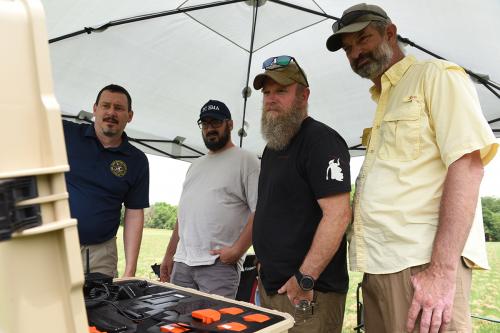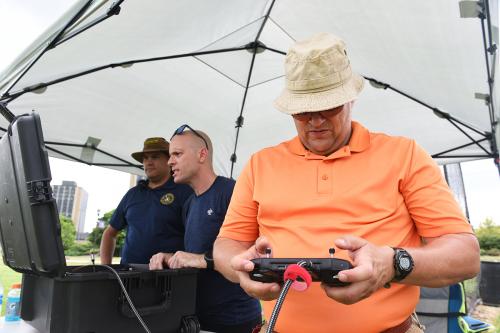WIU GIS Center, School of LEJA Provide Hands-On Training, Learning Opportunities
June 16, 2021

First responders participated in an eight-hour, hands-on sUAS Flight Operations course, provided free of charge by Western Illinois University.
[Download Print-Quality Image]
MACOMB, IL - - Western Illinois University emergency management students, along with professional emergency personnel and educators, have the benefit of hands-on training and numerous other learning opportunities as a result of a collaborative partnership between the WIU GIS Center, WIU School of Law Enforcement and Justice Administration (LEJA)'s emergency management degree program and the Illinois Law Enforcement Training and Standards Board Executive Institute (ILETSBEI) based at WIU.
Recently, a hands-on (drone) sUAS Flight Operations Course was held on the WIU-Macomb campus, where participants learned how to fly drones to perform emergency response operations, such as search and rescue, using scenario-based training. In addition, two virtual drone-related classes were held during the spring semester, which were composed of more than 50 students from WIU, along with area emergency management agencies, police departments, fire departments, the Illinois State Police and the Illinois Emergency Management Agency. Those classes, held in March, focused on the Unmanned Aerial System (UAS) certification by the Federal Aviation Administration (FAA) that is mandatory for practitioners and students to use drones and drone-related technology in any professional operations in the area of public safety from natural disasters, emergencies, to search and rescue. The June 12 hands-on program was the culminating class for the series, which was led by Chad Sperry, director of the WIU GIS Center.
According to Sperry, the combination of GIS and UAS provides unparalleled, situational awareness, and life-saving capabilities in emergency response situations.
"The combination of these two technologies drastically improves emergency operations planning and preparedness for both natural and man-made disasters, in addition to pandemic response, mitigation and recovery," he added.
Eric Arnold of the ILETSBEI noted that through WIU's center and its partnership with WIU's School of Law Enforcement and Justice Administration, Western has taken "a bold step in advancing our regional and statewide capability to harness these two technologies to better serve our citizens. The end goal is to harness technology to enhance our ability to prepare for, respond to, mitigate and recover from disasters."
WIU's emergency management degree program within the School of LEJA was completely overhauled last year to better meet the needs of students within the program and their careers following graduation.
"We reviewed and revised the program as there is a growing and expansive number of emergencies and disasters occurring worldwide, and as such, there is a rising employment need for professional and qualified responders," said School of LEJA Director Jill Myers. "The newly-re-designed program offers a strategic/operational track for those seeking employment in disaster management and a tactical track for those seeking employment in first response agencies.
WIU's Bachelor of Science in Emergency Management is unique because it meets all of the standards set by the Federal Emergency Management Agency and other emergency management-related agencies and initiatives. The curriculum complies with Federal Emergency Act (FEMA)-endorsed accreditation requirements; Search and Rescue (SAR) accreditation requirements; Army 525 and Air Force 10-2051 training expectations required for civilian contractors; FBI, CIA and DEA competencies; knowledge related to National Incident Management System (NIMS) and modern technology, including GIS, drones, next generation 911 technology, digital transformation and comprehensive data systems to promote a scientific understanding and response to natural disasters, earth systems, climate and weather, while encouraging collaborative efforts with homeland security, law enforcement and fire science professionals.
"Our students enjoy working within our state-of-the-art GIS Center, our fully functioning Emergency Operation Center (EOC), and crime lab," Myers added. "The EOC and GIS Centers and the crime lab allow students to gain practical experience in responding to disasters, processing crime scenes, interacting with victims and witnesses, using drones, thermal imaging devices and simulating strategies and tactics during all-hazard incidents. Our students also assist professionals in both real and simulated events, such as perimeter control, research and low-level responders. All classes are taught by faculty who have held careers within the area they teach. Faculty have both the education and practical experience to make the classes rewarding and challenging."
WIU's Emergency Management program is the first four-year program in Illinois to offer a B.S. degree specifically in Emergency Management and is the only EM program within the state credentialed by the Illinois Board of Higher Education.
The recent UAS certification classes are part of an ongoing commitment from the School of LEJA and the emergency management program to establish a fully operational Emergency Operations Center (EOC) that serves the western region of Illinois and WIU. This center assists in providing emergency responses necessary to ensure continuity of operations during a state of emergency or disaster declaration by those authorities and provides educational and training opportunities to current and future emergency responders.
For more information WIU's GIS Center, visit wiu.edu/GIS. For more information on WIU's Emergency Management program, visit wiu.edu/academics/em.
Posted By: University Communications (U-Communications@wiu.edu)
Office of University Communications & Marketing



Connect with us: